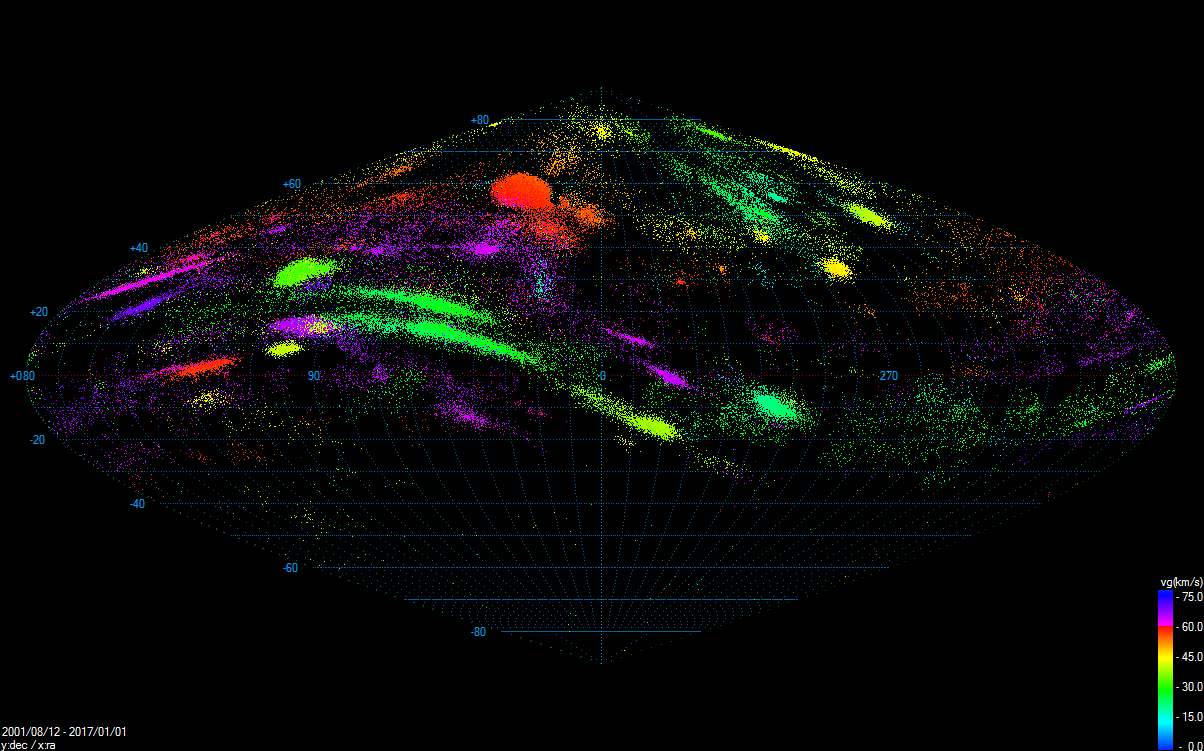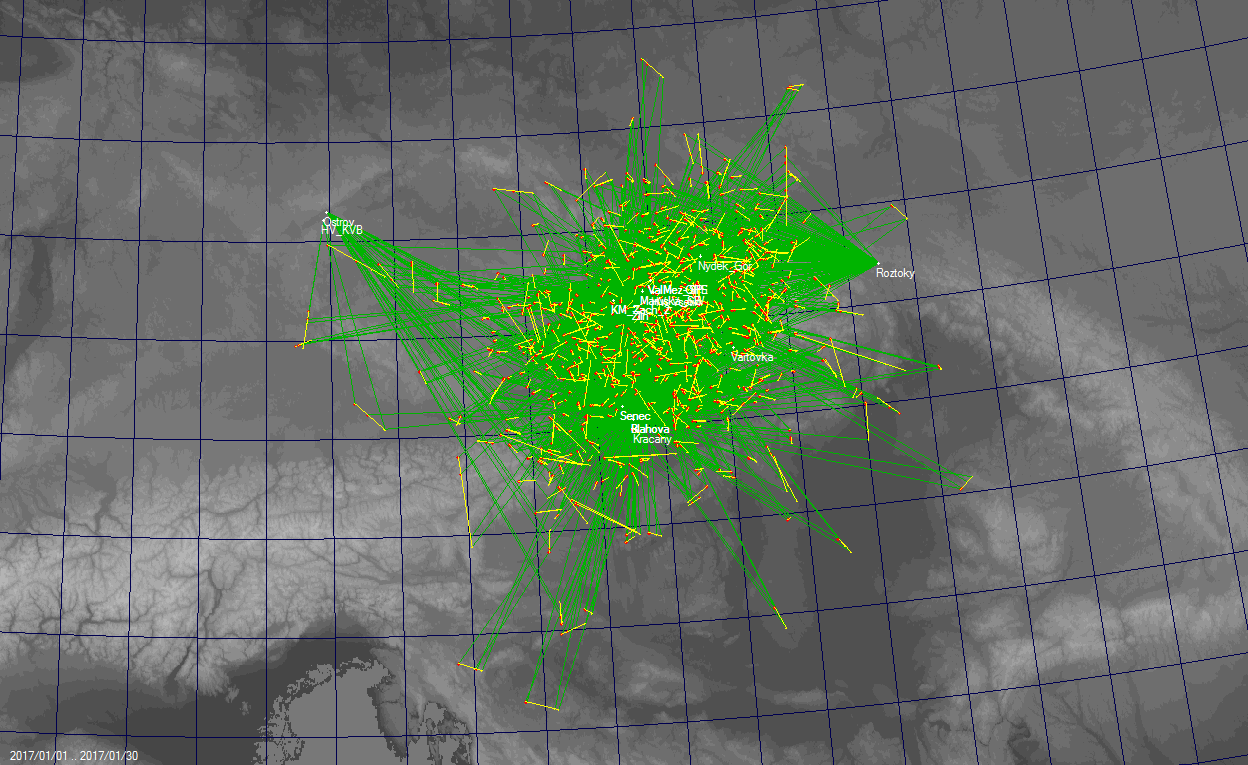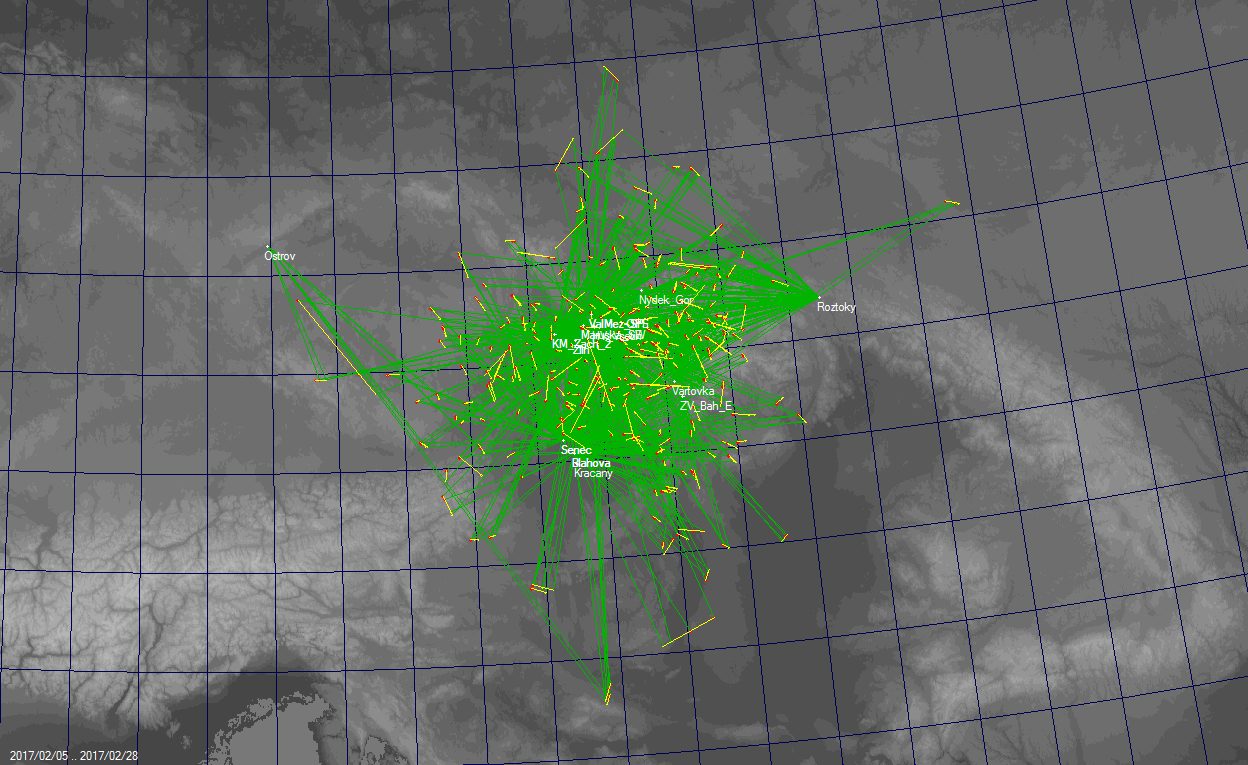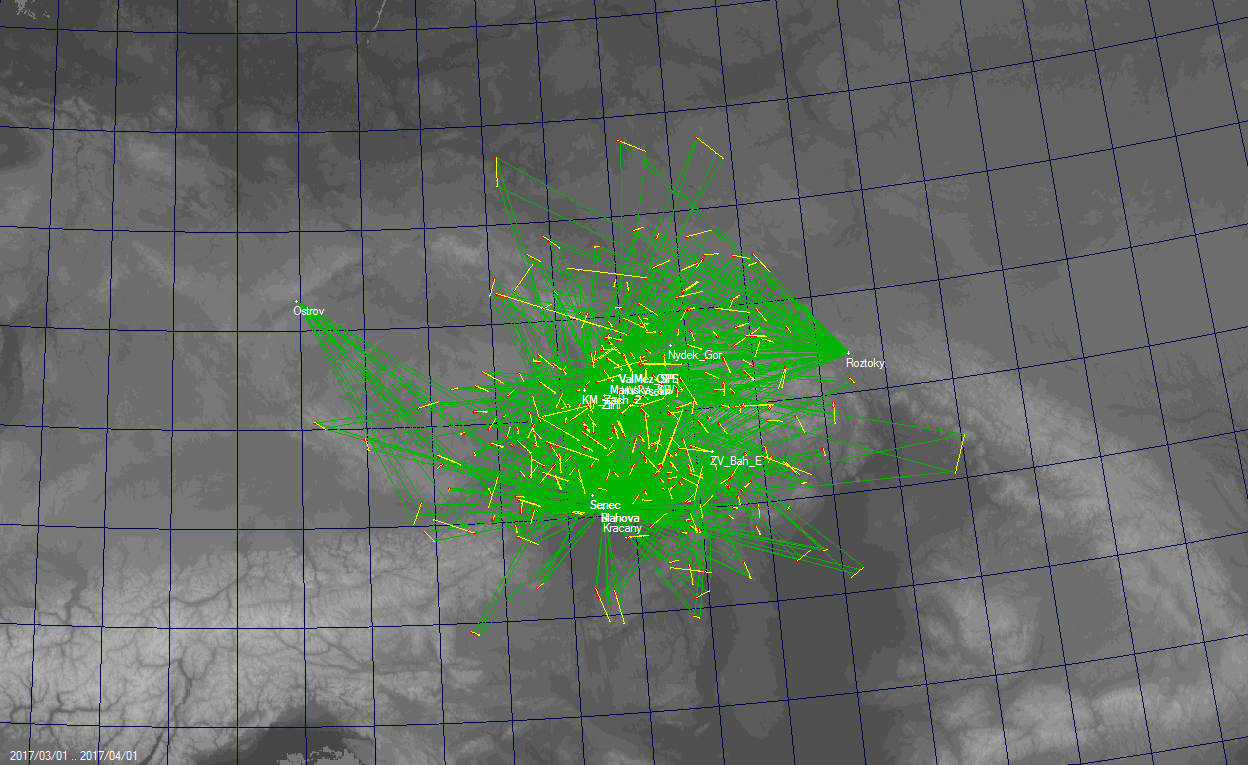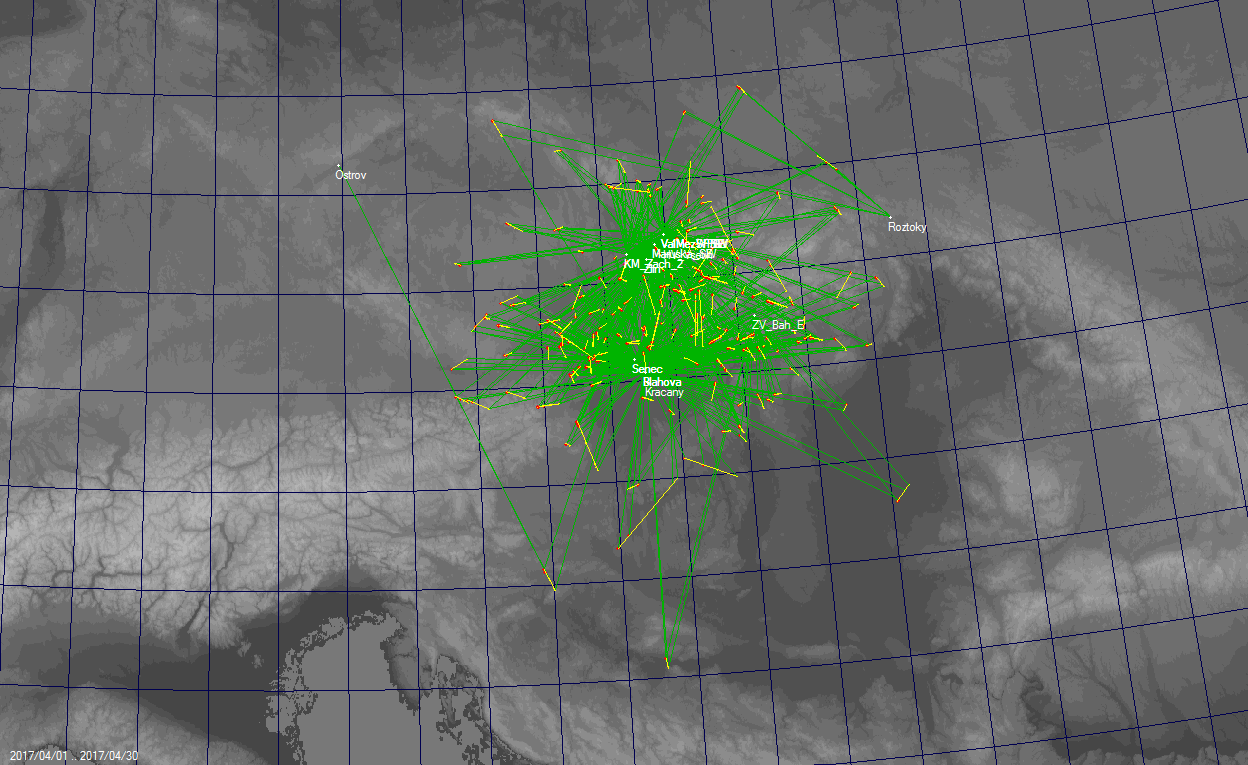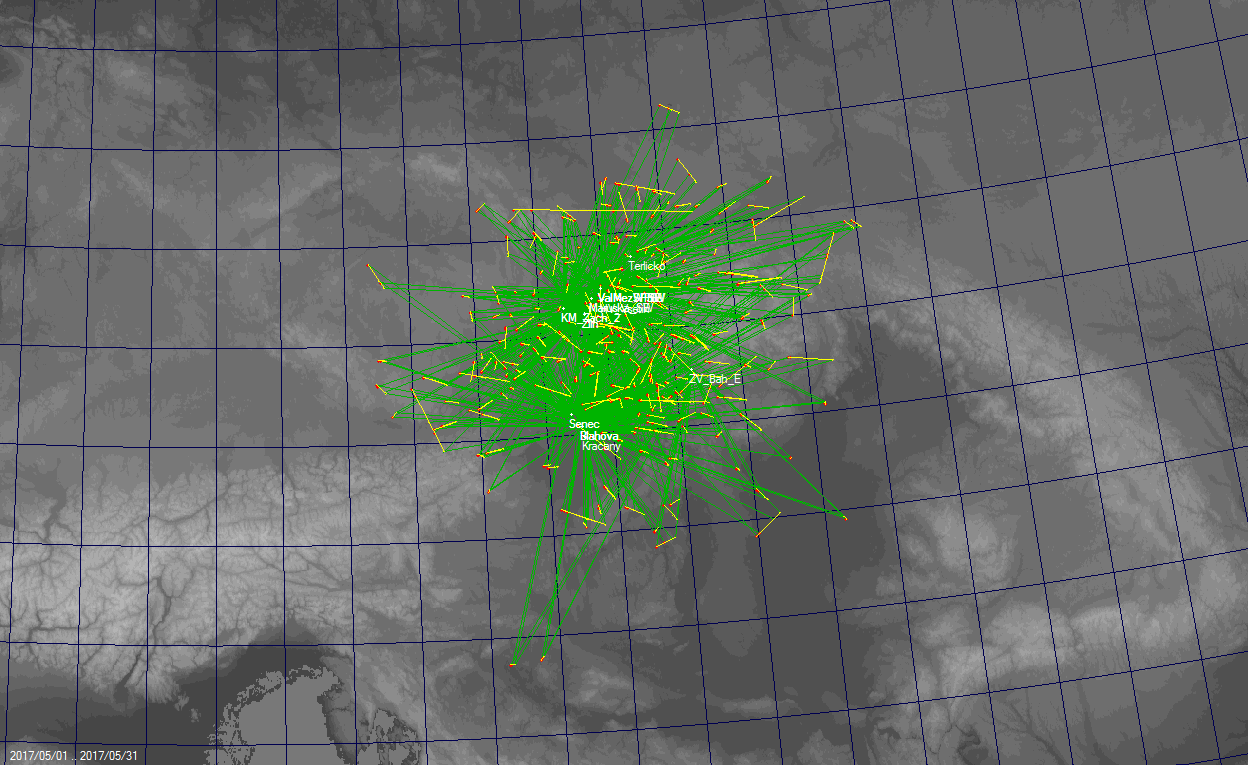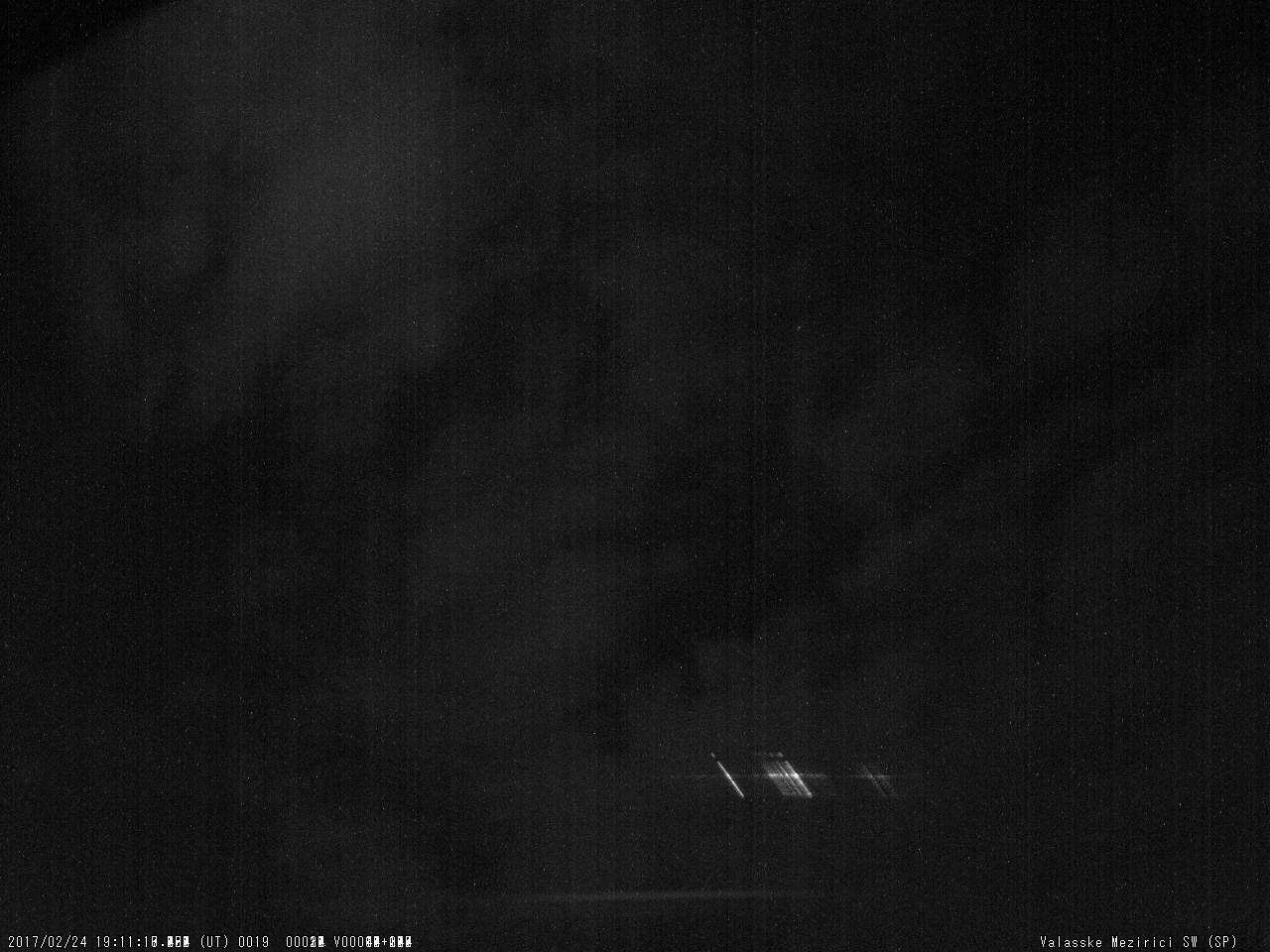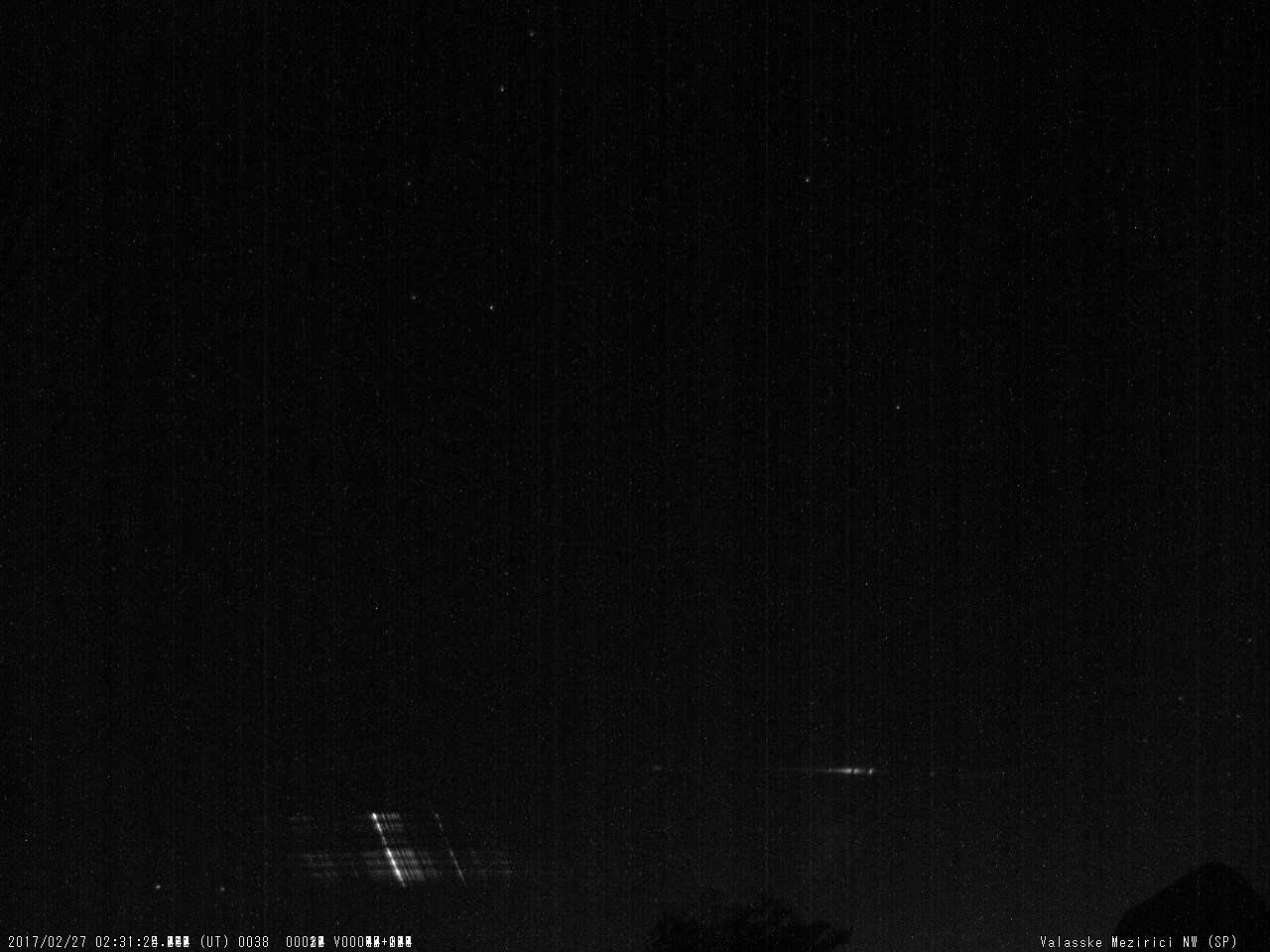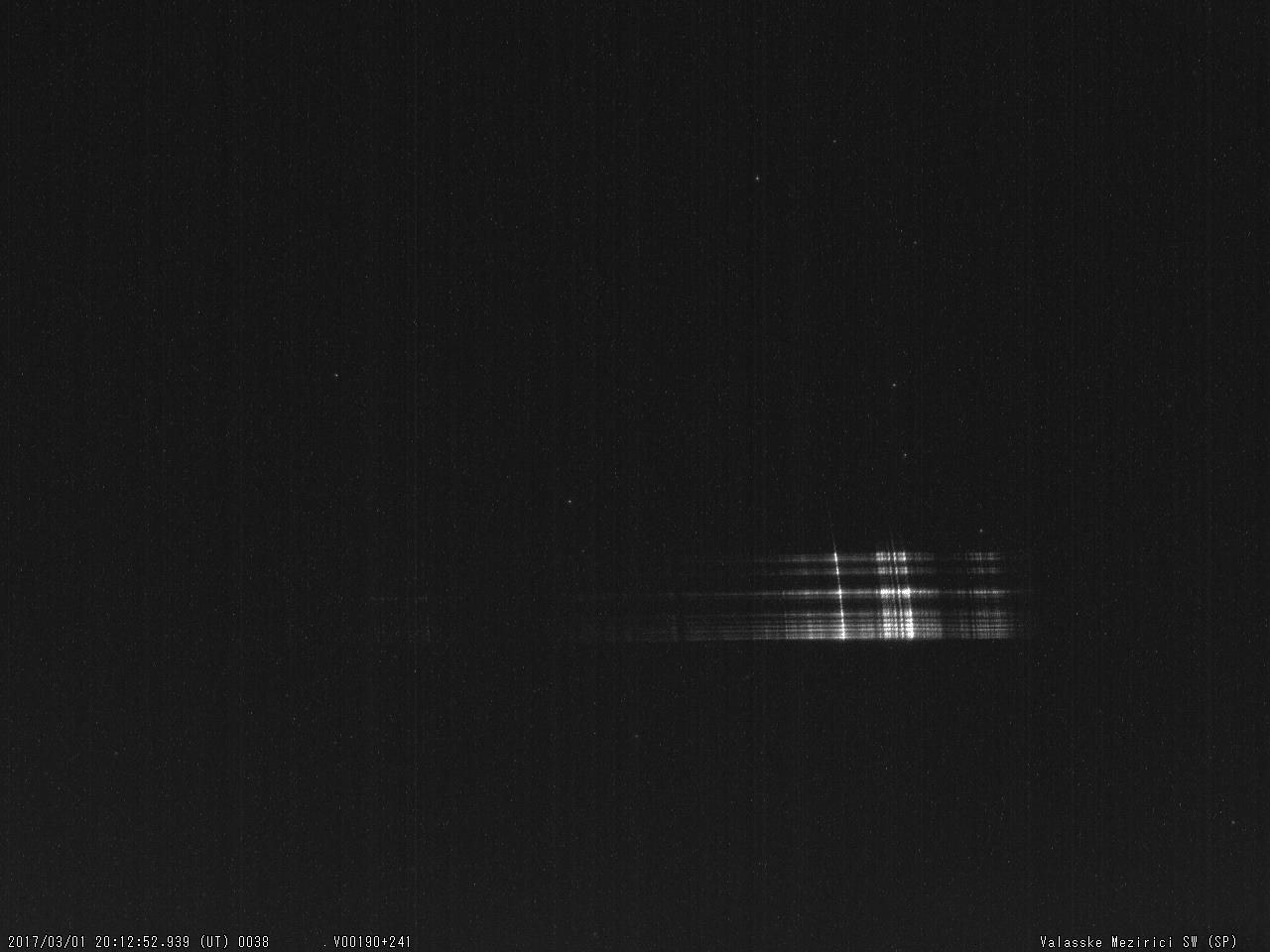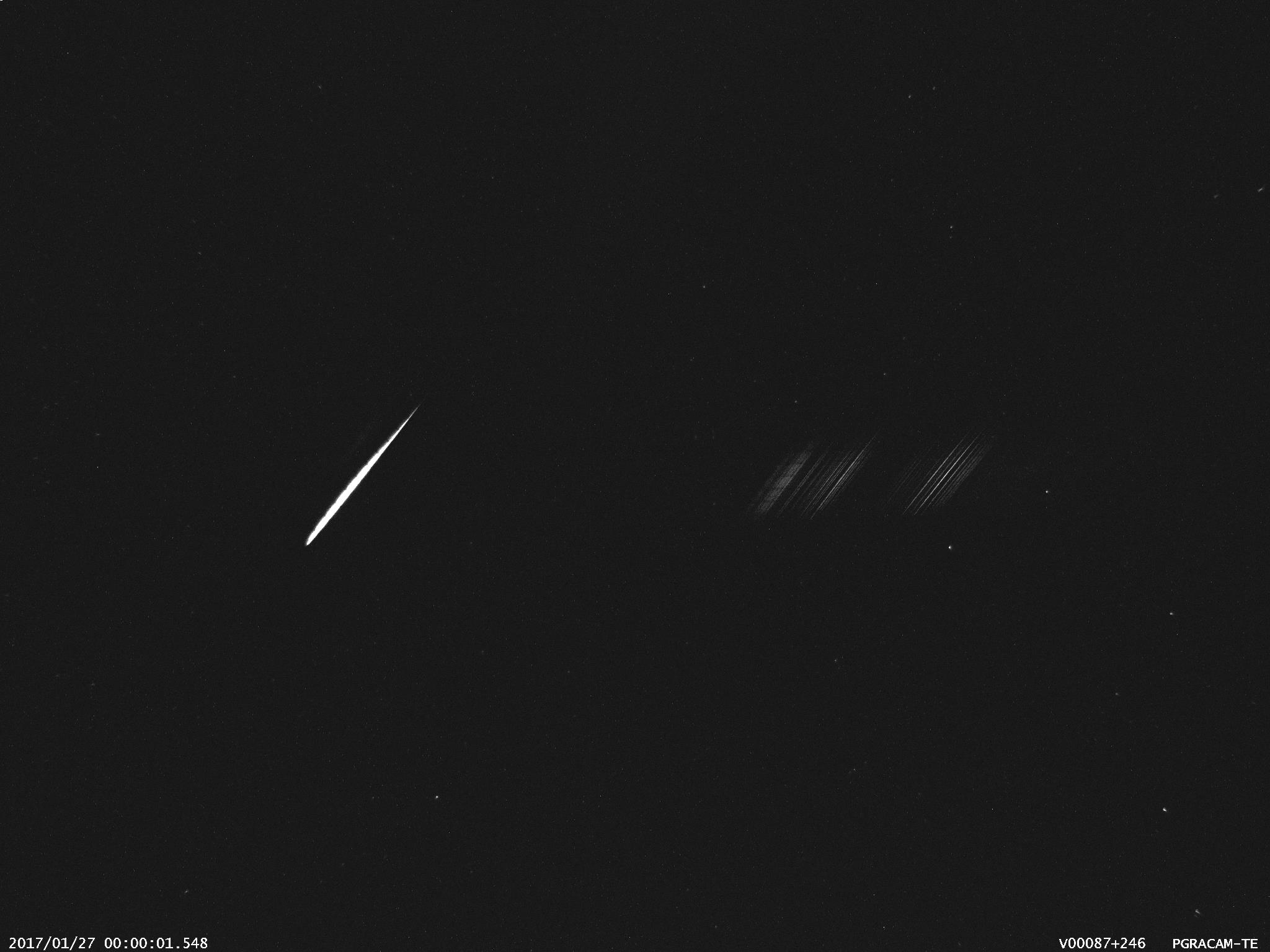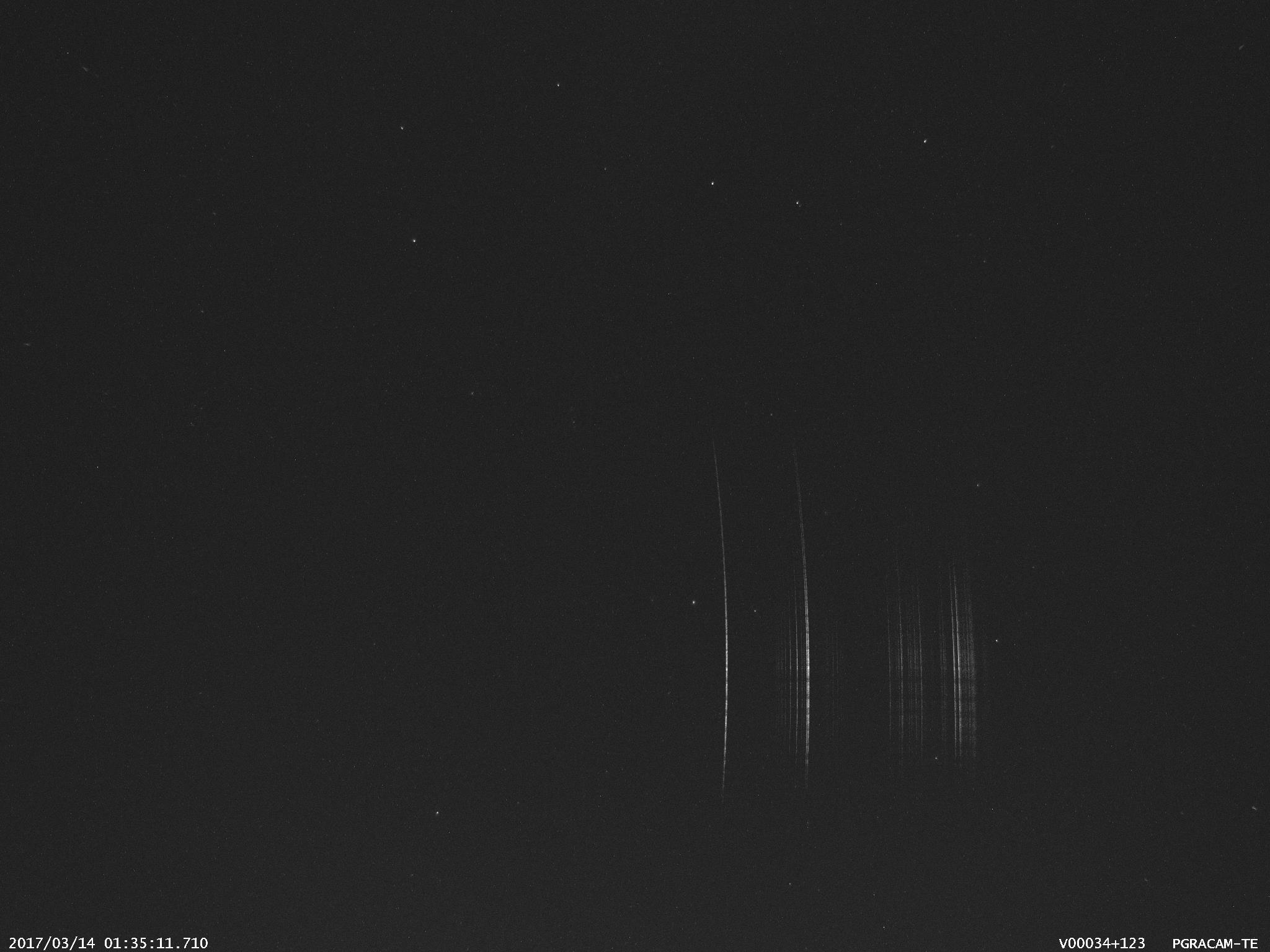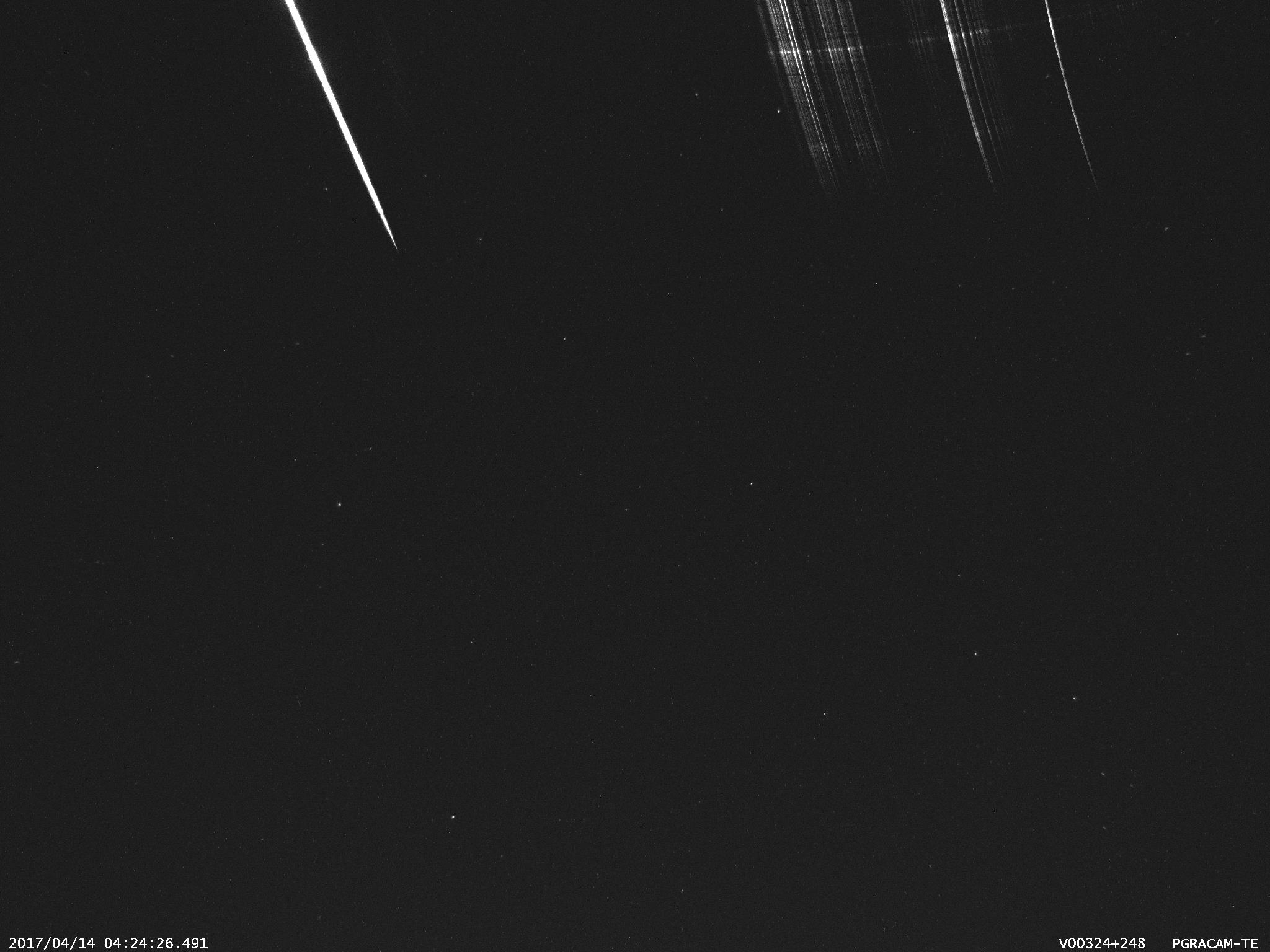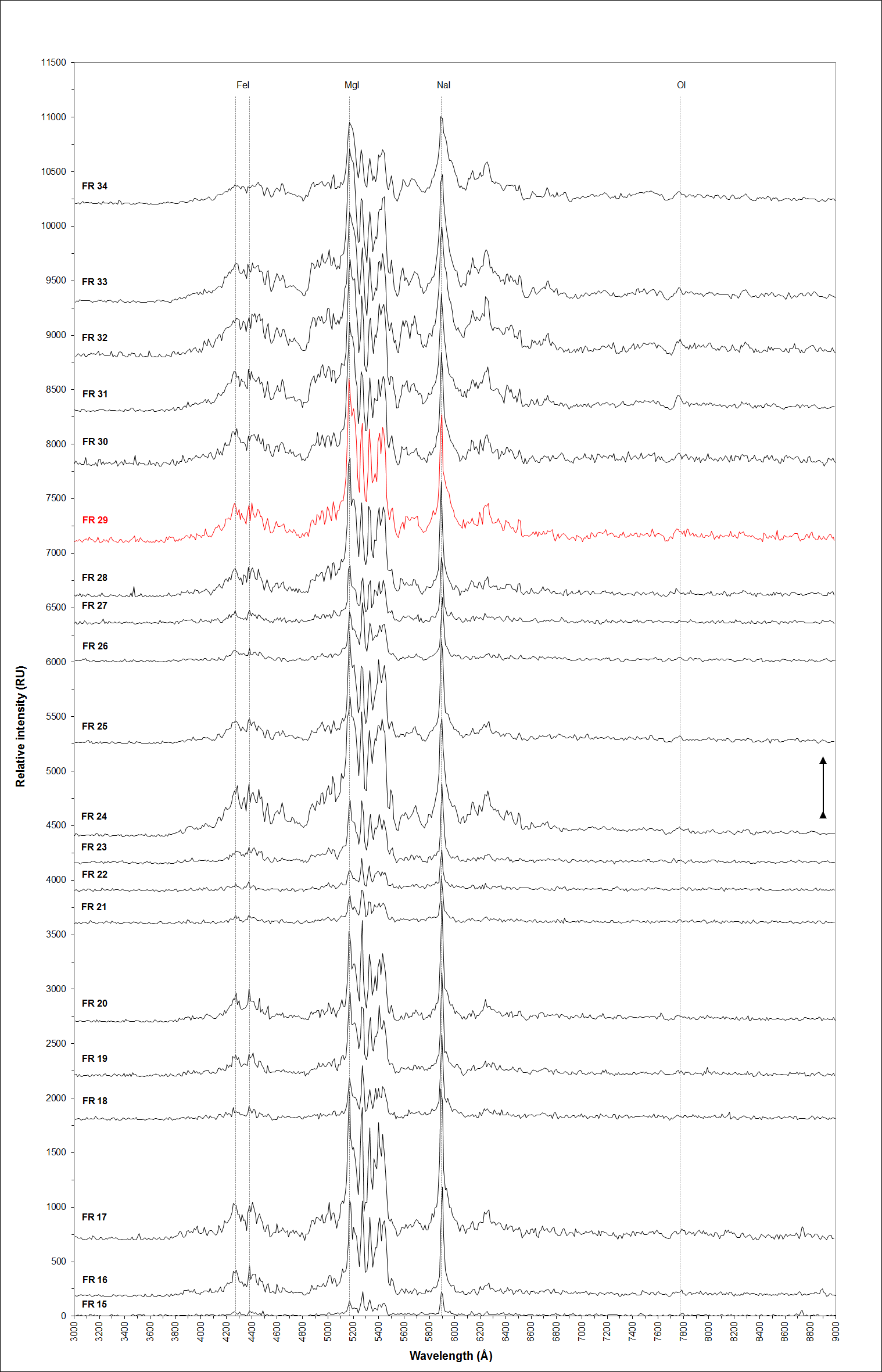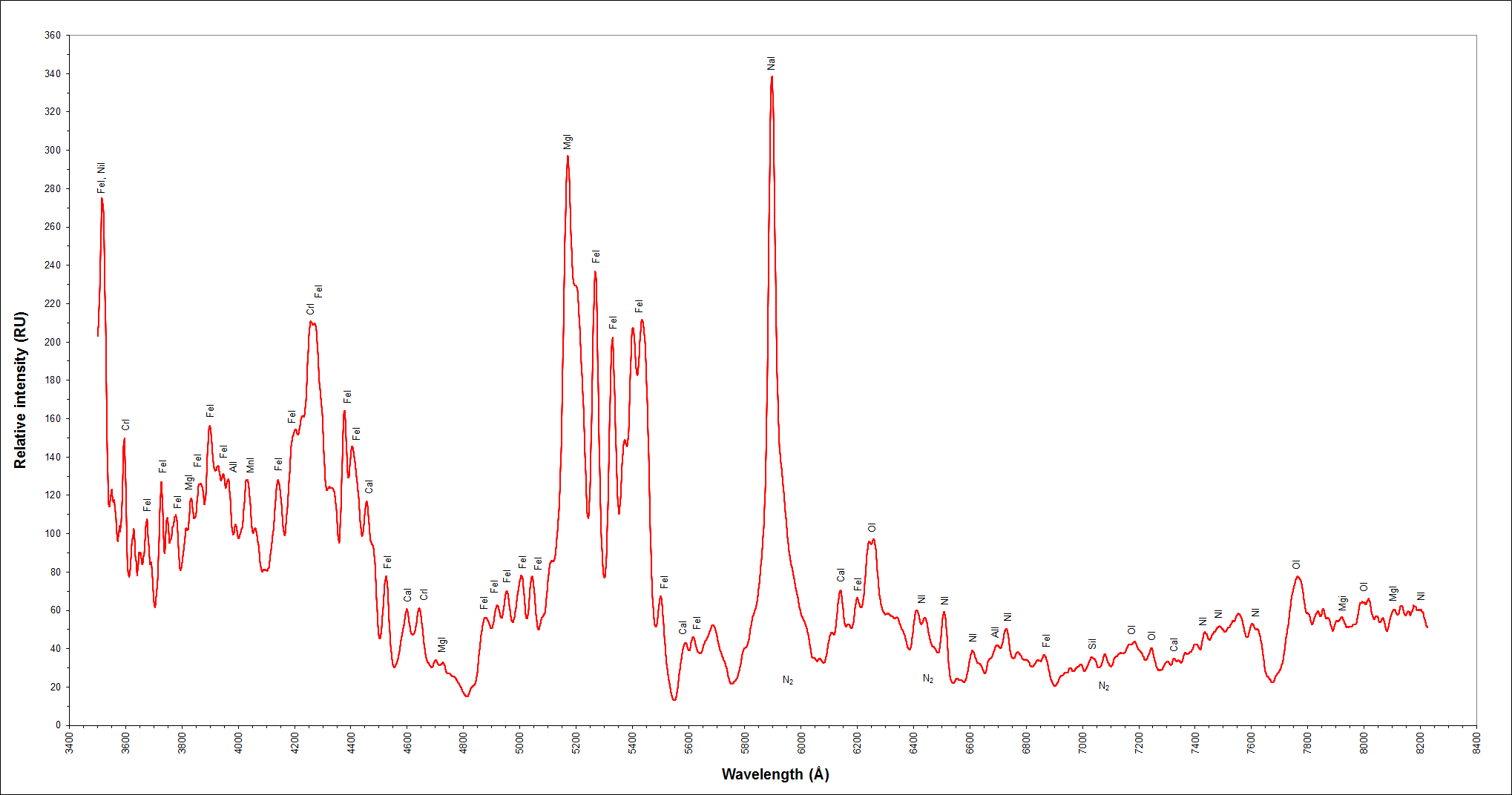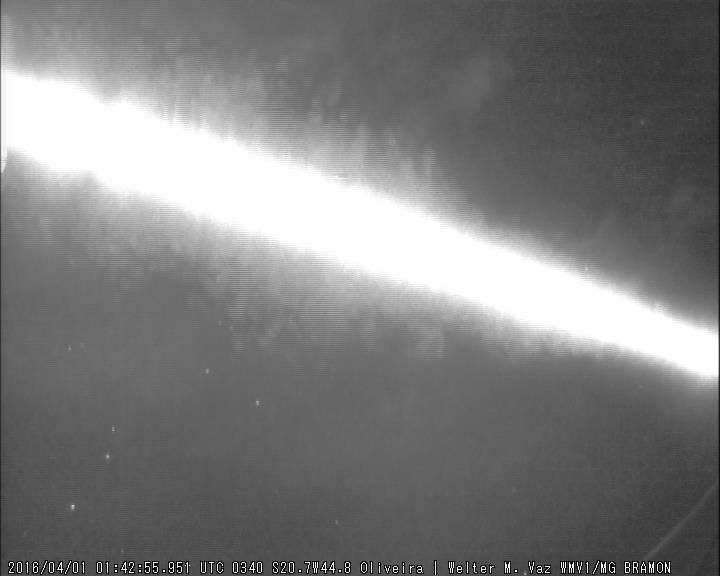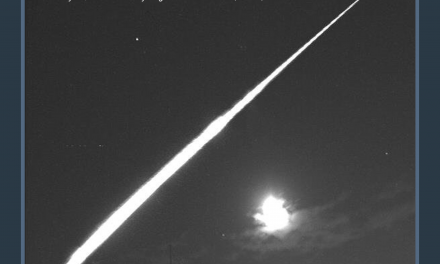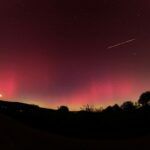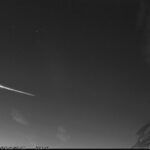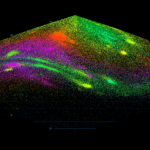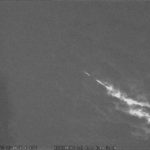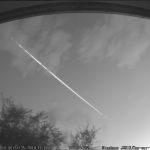Central European Meteor Newtork (CEMeNt), established in 2010, is a platform for cross-border cooperation in the field of videometeor observations between the Czech Republic and Slovakia. From the beginning, observation activities of the CEMeNt network have been coordinated with the Slovak Video Meteor Network (SVMN) and other similar networks in Central Europe (the Hungarian HMN network, the Polish PFN network, etc.). During seven years of operation, CEMeNt has undergone extensive development. A total of 38 video systems work on 18 fixed stations in the Czech Republic and Slovakia, including 6 NFC cameras and 4 cameras for spectroscopic observations. A remote station of the CEMeNt network is a spectroscopic camera located at Teide Observatory (Canary Islands, Tenerife). All data acquired by stations in the CEMeNt network are available in the EDMOND open database (Kornoš et al. 2014a,b).
Wide field systems (WF)
Video systems used in the CEMeNt network (Srba et al. 2016) are generally based on various types of sensitive CCTV cameras with CCD sensors (Sony Ex-View HAD, Sony Super HAD II, Sony Super HAD 960 H Effio) of size 1/3″ or 1/2″ with fast (~ f/1.0) varifocal lenses with PAL B image resolution (720 × 576 px). The software UFOTools (UFOCapture, UFOAnalyzer, UFOOrbit, UFORadiant), the author of which is SonotaCo (SonotaC0 2009), is used for detection and analysis. Most of the stations have a field within the range of 60-90° in the horizontal direction.
Video systems are protected against weather using heated housings (usually used for security camera systems). These stations are able to work all year long without any weather restrictions. Most stations are fully autonomous and can be controlled by remote access from an external computer.
In the first half of 2017, a total of 10,298 single station meteors were recorded at the CEMeNt stations, of which 2,250 orbits were obtained (the so-called Q0 orbits, ie without application of qualitative criteria). The largest number of recorded orbits belong to the Quadrantid meteor shower, and Blahová (SK) recorded the largest number of single station meteors. The statistical summary by month, or by individual stations is shown in Tab. 1-3 and Fig. 2-7.
|
Month |
Single station meteors |
Paired single station meteors |
Number of orbits |
Stations/ orbit ratio |
|
January |
3,778 |
1,763 |
747 |
2.36 |
|
February |
1,185 |
683 |
272 |
2.51 |
|
March |
1,398 |
820 |
321 |
2.55 |
|
April |
908 |
463 |
197 |
2.35 |
|
May |
1,176 |
661 |
266 |
2.48 |
|
June |
1,853 |
1,053 |
447 |
2.36 |
|
Overall |
10,298 |
5,443 |
2,250 |
2.42 |
|
Tab. 1: Numbers of single station meteors and orbits in the CEMeNt network in the first half of 2017. Author: Jakub Koukal |
||||
|
Station |
Number of systems |
Single station meteors |
|
Blahová (SK) |
4 |
1,964 |
|
Karlovy Vary (CZ) |
2 |
333 |
|
Vsetín (CZ) |
1 |
324 |
|
Kroměříž (CZ) |
2 |
816 |
|
Kostolné Kráčany (SK) |
1 |
261 |
|
Maruška (CZ) |
2 |
1,204 |
|
Nýdek (CZ) |
4 |
234 |
|
Ostrov (CZ) |
1 |
63 |
|
Roztoky (SK) |
1 |
528 |
|
Senec (SK) |
3 |
1,017 |
|
Těrlicko (CZ) |
1 |
109 |
|
Valašské Meziříčí WF (CZ) |
2 |
1,547 |
|
Valašské Meziříčí SP (CZ) |
4 |
463 |
|
Vartovka (SK) |
1 |
281 |
|
Zvolenská Slatina (SK) |
1 |
277 |
|
Zlín (CZ) |
2 |
877 |
|
Tab. 2: Numbers of single station meteors for individual stations in the CEMeNt network in the first half of 2017. Author: Jakub Koukal |
||
|
IAU MDC |
Meteor shower |
Number of orbits |
|
SPO |
Sporadic |
5,551 |
|
QUA |
Quadrantids |
246 |
|
COM |
Comae Berenicids |
98 |
|
ETA |
Eta Aquariids |
69 |
|
LYR |
April Lyrids |
68 |
|
NBO |
Nu Bootids |
53 |
|
EVI |
Eta Virginids |
48 |
|
GUM |
Gamma Ursae Minorids |
40 |
|
TTB |
22 Bootids |
35 |
|
JRC |
June rho Cygnids |
33 |
|
Tab. 3: Numbers of orbits of individual meteor showers in the CEMeNt network in the first half of 2017. Author: Jakub Koukal |
||
Narrow Field Camera (NFC)
A new type of highly sensitive, specialized camera system with a narrow field of view was introduced in 2015. The system is called NFC (Narrow Field Camera), and 6 systems are currently in operation within the CEMeNt network (Koukal et al. 2015). The main part of the NFC system is the Meopta Meostigmat 1/50 (f/1.0) fast lens with focal length F = 50 mm. In the system, the Watec 902H2 Ultimate camera is used as a sensor with a 1/2″ CCD (Sony Ex-View HAD) chip. In combination with the Meostigmat lens, the system has a very narrow field of view with a width of ~ 7° in the horizontal direction, but at the same time the system can capture meteors up to a relative brightness of +7m, the limiting magnitude of the reference stars is +10.5m.
In the first half of 2017, a total of 2,511 single station meteors were recorded at the CEMeNt stations, of which 394 orbits were obtained (the so-called Q0 orbits, ie without application of qualitative criteria). The largest number of recorded orbits belong to the Quadrantid meteor shower, and Blahová (SK) recorded the largest number of single station meteors. The statistical summary by month, or by individual stations is shown in Tab. 4-6 and Fig. 8.
|
Month |
Single station meteors |
Paired single station meteors |
Number of orbits |
Stations/ orbit ratio |
|
January |
539 |
122 |
61 |
2.00 |
|
February |
331 |
148 |
74 |
2.00 |
|
March |
454 |
170 |
85 |
2.00 |
|
April |
308 |
120 |
60 |
2.00 |
|
May |
423 |
152 |
76 |
2.00 |
|
June |
456 |
76 |
38 |
2.00 |
|
Overall |
2,511 |
788 |
394 |
2.00 |
|
Tab. 4: Numbers of single station meteors and orbits (NFC system) in the CEMeNt network in the first half of 2017. Author: Jakub Koukal |
||||
|
Station |
Number of systems |
Single station meteors |
|
Blahová (SK) |
1 |
638 |
|
Kroměříž (CZ) |
1 |
321 |
|
Valašské Meziříčí (CZ) |
1 |
471 |
|
Senec (SK) |
1 |
411 |
|
Zákopčie (SK) |
1 |
240 |
|
Kysucké Nové Mesto (SK) |
1 |
430 |
|
Tab. 5: Numbers of single station meteors for individual stations (NFC system) in the CEMeNt network in the first half of 2017. Author: Jakub Koukal |
||
|
IAU MDC |
Meteor shower |
Number of orbits |
|
SPO |
Sporadic |
1,001 |
|
QUA |
Quadrantids |
9 |
|
MPS |
May psi Scorpiids |
8 |
|
FMV |
February mu Virginids |
8 |
|
KVI |
Kappa Virginids |
6 |
|
Tab. 6: Numbers of orbits of individual meteor showers (NFC system) in the CEMeNt network in the first half of 2017. Author: Jakub Koukal |
||
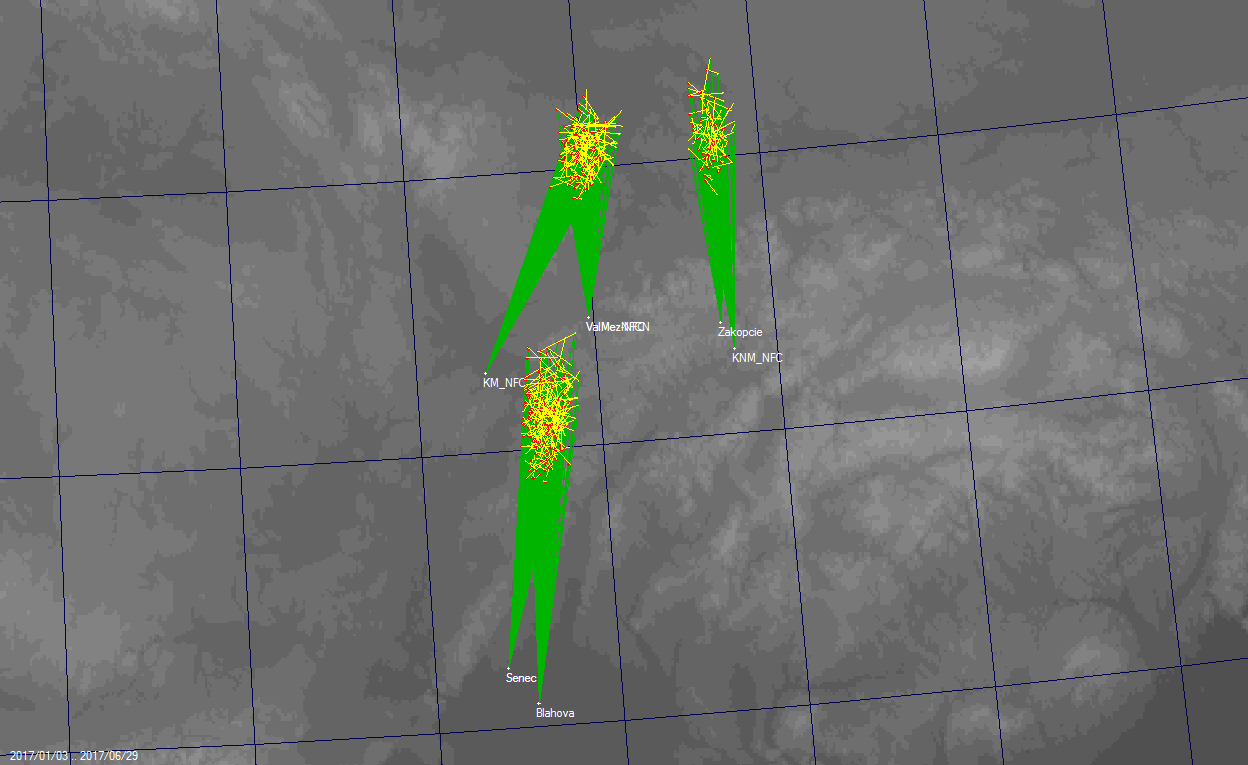 |
| Fig. 8: 2D projection of multi station orbits (NFC system) in the CEMeNt network in May 2017. Author: Jakub Koukal |
Spectrographic systems (SP)
Since 2014, CEMeNt research also focuses on spectral observations of bright meteors (Koukal et al. 2016). Spectroscopic systems use the classical design of wide field systems with a diffraction grating added in front of the lens. The first, currently unused system used a classic CCTV camera (as well as wide field systems) with a diffraction grating (500 lines/mm) added in front of the lens. The resolution of the spectrum recorded by this system was ~ 33 Å/px. Systems installed in 2015 at the Valašské Meziříčí Observatory use QHY5LII-M cameras with 1/3″ CMOS chip (Aptina MT9M034, 1280 × 960 px). The diffraction grating (1000 lines/mm) is placed in front of the Tamron M13VG308 (f / 1.0) fast megapixel varifocal lens. The field of view of the spectrographs within the range of 60-70° in the horizontal direction, combined with the diffraction grating, allows the resolution of recorded spectra to be within the range of 8.0-8.5 Å/px. The software UFOTools (UFOCapture, UFOAnalyzer, UFOOrbit, UFORadiant), the author of which is SonotaCo, is used for detection and analysis.
In the first half of 2017, 463 single station meteors and 9 spectra of bright meteors were recorded on the CEMeNt spectrographic systems. The statistical overview of individual systems is shown in Tab. 7, samples of the recorded spectra are shown in Fig. 9-12.
|
System designation |
Camera type |
Single station meteors |
Spectra |
|
SPSW V4 |
QHY5LII-M |
79 |
0 |
|
SPSE V5 |
QHY5LII-M |
49 |
1 |
|
SPNE V6 |
QHY5LII-M |
93 |
1 |
|
SPNE * |
QHY5LII-M |
132 |
3 |
|
SPNW * |
QHY5LII-M |
62 |
2 |
|
SPNW V7 |
PG GS3-U3-32S4M-C |
48 |
2 |
|
Overall |
463 |
9 |
|
|
* since March 2017, the cameras have been replaced by SPNW V7 and SPNE V6 in this azimuth Tab. 7: Numbers of single station meteors and recorded spectra for individual spectrographic systems in the CEMeNt network in the first half of 2017. Author: Jakub Koukal |
|||
In 2016 the high-resolution spectrograph was installed at the Teide Observatory (Tenerife, Canary Islands), the same system was installed at the Valašské Meziříčí Observatory in 2017. Systems use monochromatic cameras PointGrey Grasshoper3 GS3-U3-32S4M-C with 1/1.8″ CMOS chip (Sony Pregius IMX252). The resolution of the installed sensor is 2048 × 1536 pixels, the frame rate is set at 15 fr/s. Spectrographs are equipped with fast lenses VS Technology (9 Mpx, f/1.4) with focal length F = 6 mm. The field of view of spectrograph is 60 × 45°, diffraction grating (1000 lines/mm) is used due to the resolution of the installed chip and the field of view, the resolution of the recorded spectrum is 4.8 Å/px. The software UFOTools (UFOCaptureHD, UFOAnalyzer, UFOOrbit, UFORadiant), the author of which is SonotaCo, is used for detection and analysis.
In the first half of 2017, 618 single station meteors and 27 spectra of bright meteors were recorded on the spectrographic systems at the Teide Observatory (PGRACAM-TE). The statistical summary by month is shown in Tab. 8, samples of the recorded spectra are shown in Fig. 13-16.
|
Month |
Single station meteors |
Spectra |
|
January |
132 |
4 |
|
February |
90 |
4 |
|
March |
93 |
4 |
|
April |
106 |
5 |
|
May |
142 |
7 |
|
June |
55 |
3 |
|
Overall |
618 |
27 |
|
Tab. 8: Numbers of single station meteors and recorded spectra for individual months (spectrographic systém PGRACAM-TE) in the first half of 2017. Author: Jakub Koukal |
||
Spectrum analysis – fireball 20170301_201251
The projection of the beginning of the atmospheric path was located at the coordinates N49,474° E20,045°, the height of the fireball at this time was 79,2 ± 0,1 kilometers above the Earth’s surface. The end of the projection of the atmospheric path was located at the coordinates N49,602° E20,089°, the height of the fireball at this time was 40,5 ± 0,1 km kilometers above the Earth’s surface. It was a slow meteor, the geocentric velocity of the meteoroid before entering the gravitational field of the Earth was 9,26 ± 0,16 km/s (including the deceleration effect), the orbital elements of the meteoroid orbit were as follows: a = 2.255 ± 0.055 AU, q = 0.9583 ± 0.0006 AU, e = 0.575 ± 0.010, i = 0.69 ± 0.04°, ω = 204.55 ± 0.07°, Ω = 341.2311°. Fireball belonged to sporadic meteors (SPO) with geocentric radiant RA = 115,7 ± 0,1°, DEC = 24,1 ± 0,2°. The Tisserand´s parameter in relation to the Jupiter TJ = 3.38 ± 0.06 shows the asteroid origin of the body in the inner part of the main asteorid belt. The meteoroid orbit in the Solar System is very similar to the orbit of asteroid 2016 DL1 (DD = 0.022), which is probably the parent body of the fireball 20170301_201251.
In the calibrated aggregate spectrum of the fireball, the emission lines of the elements were identified in the following representation: iron (FeI), magnesium (MgI), sodium (NaI), manganese (MnI), aluminum (AlI), chromium (CrI), silicon (SiI) and relatively weak calcium lines (CaI). The ratio of the emission of elements belonging to the Earth’s ionized atmosphere to magnesium (N2/MgI, NI/MgI and OI/MgI) is low, since this does not depend on the mass of the body but on its velocity. This means that the amount of emission of these elements is directly proportional to the weight of the body, but the rate coefficient increases with the velocity of the meteors. The ratio of relative intensities of OI-1/MgI-2 multipletes is only 0.262, for meteor showers with high geocentric velocities (eg Leonid or Perseid), this ratio normally exceeds 3 and often reaches values close to number 6. The total ratio of relative intensities of MgI-2:NaI-1:FeI-15 is 0.204:0.224:0.572, due to the high iron content in the fireball spectrum, it was a chondritic material.
Acknowledgement
Acknowledgment belongs to all station owners, operators and observers for their long-term and precise work, which enabled the establishment and development of the CEMeNt network. Acknowledgment also belongs to all interested institutions in support of activities and network growth. The KOSOAP (Cooperating Network of Astronomic Observational Projects, in Czech: Kooperující síť v oblasti astronomických odborně-pozorovatelských programů) and RPKS (Evolvement of the Cross Border Network for Scientific Work and Education, in Czech: Rozvoj přeshraniční kooperující sítě pro odbornou práci a vzdělávání) projects were realized by the Valašské Meziříčí Observatory (CZ) and Kysucké Nové Město Observatory (SR) in cooperation with the Society for Interplanetary Matter. Projects were co-funded by European Union (Cross-border Cooperation Programme Slovak Republic – Czech Republic 2007-2013). The project for the purchase and operation of high-resolution spectrographs is partly subsidized by the Program for Regional Cooperation of the Academy of Sciences of the Czech Republic, Reg. No. R200401521, by the grant of APVV-0517-12 (FMFI UK) and by the internal grant of the J. Heyrovský Institute of Physical Chemistry No. 994316. In addition, companies DEZA, a. s. and CS CABOT, spol. s r. o., also contributed to the purchase of instrumentation at the Valašské Meziříčí Observatory.
References
Kornoš L., Koukal J., Piffl R., and Tóth J. (2014a). EDMOND Meteor Database. In Gyssens M. and Roggemans P., editors. Proceedings of the International Meteor Conference, Poznań, Poland, Aug. 22-25, 2013. IMO, 23–25.
Kornoš L., Matlovič P., Rudawska R., Tóth J., Hajduková M. Jr., Koukal J., Piffl R. (2014b). Confirmation and characterization of IAU temporary meteor showers in EDMOND database. In Jopek T.J., Rietmeijer F.J.M., Watanabe J., Williams I.P., editors. Proceedings of the Meteoroids 2013 Conference, Aug. 26-30, 2013, A.M. University, Poznań, Poland, 225-233.
Koukal, J., Srba J., Gorková S. (2015). NFC – Narrow Field Camera. In Rault J.-L. and Roggemans P., editors. Proceedings of the International Meteor Conference, Mistelbach, Austria, 27-30 August 2015. IMO, 90-93.
Koukal J., Srba J., Gorková S., Lenža L., Ferus M., Civiš S., Knížek A., Kubelík P., Kaiserová T., Váňa P. (2016). Meteors and meteorites spectra. In Roggemans P. and Roggemans A., editors. Proceedings of the International Meteor Conference, Egmond, Netherlands, June 2-5, 2016. International Meteor Organization, 137–142.
Srba J., Koukal J., Ferus M., Lenža L., Gorková S., Civiš S., Simon J., Csorgei T., Jedlička M., Korec M., Kaniansky S., Polák J., Spurný M., Brázdil T., Mäsiar J., Zima M., Delinčák P., Popek M., Bahýl V., Piffl R., and Čechmanem M. (2016). Central European MetEor NeTwork: Current status and future activities. WGN, Journal of the International Meteor Organization, 44:3, 2016, 71–77.
SonotaCo (2009). A meteor shower catalog based on video observations in 2007-2008. WGN, Journal of the International Meteor Organization 37:2, 2009, 55-62.

